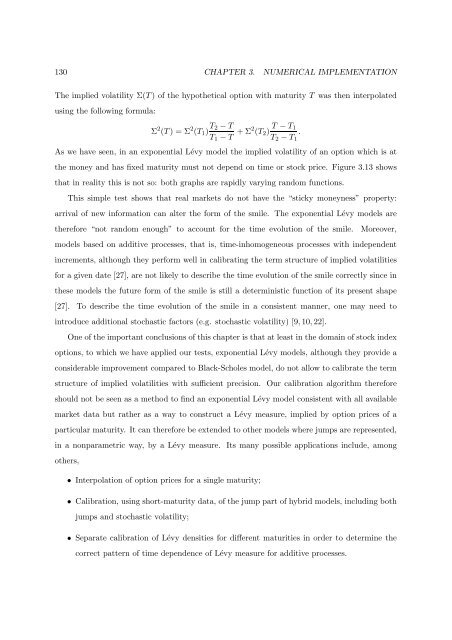Processus de Lévy en Finance - Laboratoire de Probabilités et ...
Processus de Lévy en Finance - Laboratoire de Probabilités et ...
Processus de Lévy en Finance - Laboratoire de Probabilités et ...
You also want an ePaper? Increase the reach of your titles
YUMPU automatically turns print PDFs into web optimized ePapers that Google loves.
130 CHAPTER 3. NUMERICAL IMPLEMENTATION<br />
The implied volatility Σ(T ) of the hypoth<strong>et</strong>ical option with maturity T was th<strong>en</strong> interpolated<br />
using the following formula:<br />
Σ 2 (T ) = Σ 2 (T 1 ) T 2 − T<br />
T 1 − T + Σ2 (T 2 ) T − T 1<br />
T 2 − T 1<br />
.<br />
As we have se<strong>en</strong>, in an expon<strong>en</strong>tial Lévy mo<strong>de</strong>l the implied volatility of an option which is at<br />
the money and has fixed maturity must not <strong>de</strong>p<strong>en</strong>d on time or stock price. Figure 3.13 shows<br />
that in reality this is not so: both graphs are rapidly varying random functions.<br />
This simple test shows that real mark<strong>et</strong>s do not have the “sticky moneyness” property:<br />
arrival of new information can alter the form of the smile. The expon<strong>en</strong>tial Lévy mo<strong>de</strong>ls are<br />
therefore “not random <strong>en</strong>ough” to account for the time evolution of the smile.<br />
Moreover,<br />
mo<strong>de</strong>ls based on additive processes, that is, time-inhomog<strong>en</strong>eous processes with in<strong>de</strong>p<strong>en</strong><strong>de</strong>nt<br />
increm<strong>en</strong>ts, although they perform well in calibrating the term structure of implied volatilities<br />
for a giv<strong>en</strong> date [27], are not likely to <strong>de</strong>scribe the time evolution of the smile correctly since in<br />
these mo<strong>de</strong>ls the future form of the smile is still a <strong>de</strong>terministic function of its pres<strong>en</strong>t shape<br />
[27]. To <strong>de</strong>scribe the time evolution of the smile in a consist<strong>en</strong>t manner, one may need to<br />
introduce additional stochastic factors (e.g. stochastic volatility) [9, 10, 22].<br />
One of the important conclusions of this chapter is that at least in the domain of stock in<strong>de</strong>x<br />
options, to which we have applied our tests, expon<strong>en</strong>tial Lévy mo<strong>de</strong>ls, although they provi<strong>de</strong> a<br />
consi<strong>de</strong>rable improvem<strong>en</strong>t compared to Black-Scholes mo<strong>de</strong>l, do not allow to calibrate the term<br />
structure of implied volatilities with suffici<strong>en</strong>t precision. Our calibration algorithm therefore<br />
should not be se<strong>en</strong> as a m<strong>et</strong>hod to find an expon<strong>en</strong>tial Lévy mo<strong>de</strong>l consist<strong>en</strong>t with all available<br />
mark<strong>et</strong> data but rather as a way to construct a Lévy measure, implied by option prices of a<br />
particular maturity. It can therefore be ext<strong>en</strong><strong>de</strong>d to other mo<strong>de</strong>ls where jumps are repres<strong>en</strong>ted,<br />
in a nonparam<strong>et</strong>ric way, by a Lévy measure. Its many possible applications inclu<strong>de</strong>, among<br />
others,<br />
• Interpolation of option prices for a single maturity;<br />
• Calibration, using short-maturity data, of the jump part of hybrid mo<strong>de</strong>ls, including both<br />
jumps and stochastic volatility;<br />
• Separate calibration of Lévy <strong>de</strong>nsities for differ<strong>en</strong>t maturities in or<strong>de</strong>r to <strong>de</strong>termine the<br />
correct pattern of time <strong>de</strong>p<strong>en</strong><strong>de</strong>nce of Lévy measure for additive processes.
















